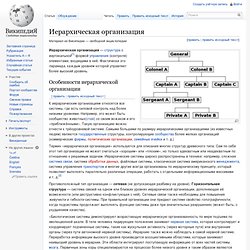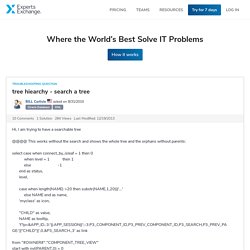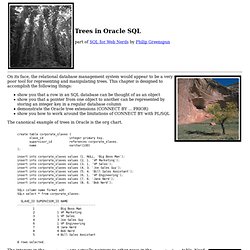

Hierarhical system. Иерархическая организация — структура с вертикальной[1] формой управления (контроля) элементами, входящими в неё.

Фактически это пирамида, каждым уровнем которой управляет более высокий уровень. Особенности иерархической организации[править | править исходный текст] К иерархическим организациям относятся все системы, где есть силовой контроль над более низкими уровнями. Например, это может быть сообщество животных(стая) со своим вожаком и его «приближёнными». Такую организацию можно отнести к трёхуровневой системе. Термин «иерархическая организация» используется для описания многих структур древесного типа. Противоположный тип организации — сетевая (не допускающая разбивку на уровни). «Биологические системы демонстрируют возрастающую иерархическую организованность по мере подъема по эволюционной шкале.
См. также[править | править исходный текст] Примечания[править | править исходный текст]
Turning a Tree into a Navigation Aid – APEX Blog. I haven’t had much use for Trees in APEX in the past.

However, when trying to decide on a navigational aid in our new development project I’ve turned to Trees as a possible solution. We’ve taken the decision to use one of the built in themes and customise it for our purpose. Once we had decided on the theme it was quickly decided that the breadcrumb region took up too much space and wasn’t really fit for purpose so wouldn’t be used. We needed a solution so that users could quickly navigate to different areas of the application and also see how they got to the page they’re on and where they are within the application.
The Tree style seemed like the ideal solution but a basic Tree would not do what we wanted, so some thought was required. Trees in APEX are used to navigate to a specific page in the application passing relevant information to items in this page. First I created a simple table to store details of the page: Then insert some values into this table, for example: Tree hiearchy - search a tree : tree, apex, connect by.
Hi, I am trying to have a searchable tree @@@@ This works without the search and shows the whole tree and the orphans without parents: select case when connect_by_isleaf = 1 then 0 when level = 1 then 1 else -1 end as status, level, case when length(NAME) >20 then substr(NAME,1,20)||'...' else NAME end as name, 'myclass' as icon, "CHILD" as value, NAME as tooltip, 'f?

From "#OWNER#". " @@@@@ This works with the search only for those that are one generation down: select case when connect_by_isleaf = 1 then 0 when level = 1 then 1 else -1 end as status, level, case when length(NAME) >20 then substr(NAME,1,20)||'...' from "#OWNER#". " @@@@ but I want the search to find something 4 generations down and show that branch all the way to the first generation, the top. Any help available on this? Representing Trees in Oracle SQL. On its face, the relational database management system would appear to be a very poor tool for representing and manipulating trees.

This chapter is designed to accomplish the following things: show you that a row in an SQL database can be thought of as an object show you that a pointer from one object to another can be represented by storing an integer key in a regular database column demonstrate the Oracle tree extensions (CONNECT BY ... PRIOR) show you how to work around the limitations of CONNECT BY with PL/SQL The canonical example of trees in Oracle is the org chart. The integers in the supervisor_id are actually pointers to other rows in the corporate_slaves table. Need to display an org chart?
APEX. XML. ALGIRITMES. JAVA. Grabli.